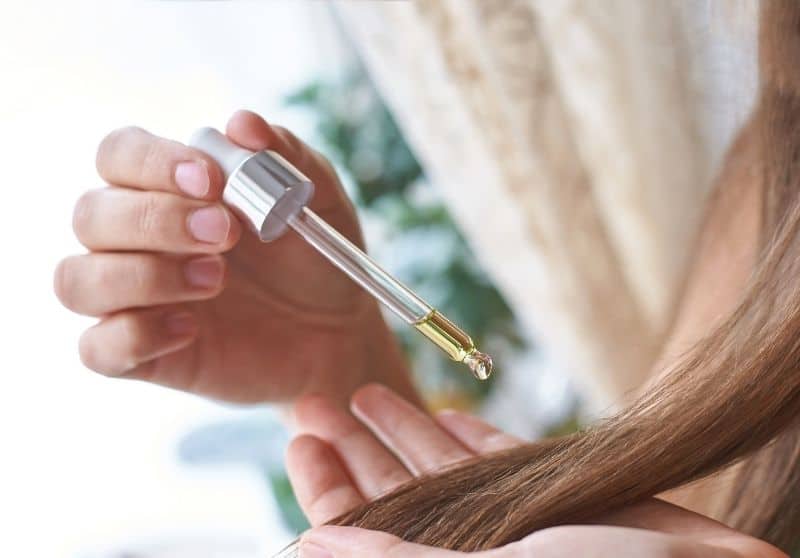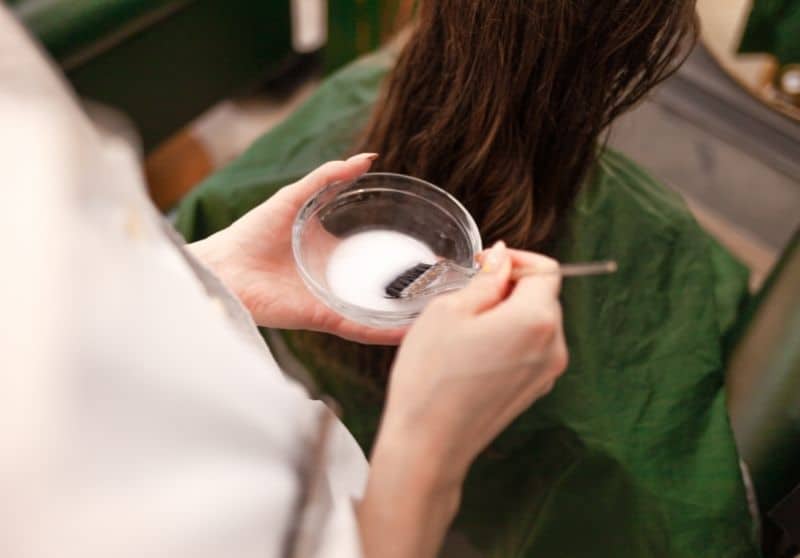Keratin is a protein and is one of the major building blocks for your hair. You’ll have seen keratin added to haircare products, and may even have heard of keratin treatments. But does keratin remove hair dye?

Keratin won’t remove hair dye, so it can’t be used as a strategy by which to do so. However, if you have a keratin treatment too soon after having colored your hair, you may end up with some discoloration and even damage.
This article will tell you how to work hair color and keratin in a way that’s beneficial for your hair, and won’t end up with you experiencing either uneven color or hair damage.
What Is Keratin?
Keratin is the dominant protein in your hair, skin, and nails.
As it’s the structural building block of your hair, many haircare products, from shampoos to masks, include keratin (or other proteins like collagen, biotin, and even wheat or silk proteins).
Keratin adds shine, strengthens, and gives an overall sense of health to your hair.
One of the main ways that you might have heard of keratin before is in what’s known as a keratin treatment.
These are chemical treatments that you can have done in a salon. They’re a semi-permanent solution for frizzy hair, as they help to flat-iron it, making it more manageable and glossier overall.
Keratin treatments can also be known by many names, including a Brazilian blowout.
Does Keratin Remove Hair Dye?
Keratin does not remove hair dye, so you cannot use it as a method by which to strip your hair of its color.
In fact, provided that you follow the right protocol, having a keratin treatment done to colored hair can help to lock that color in.
The keratin acts like a protective barrier, and will therefore prevent any color fade caused by exposure to the sun or other environmental hazards.
However, if you have a keratin treatment too soon after coloring your hair, that can result in frizzy, dry hair that might be lightened and colored unevenly, depending on the color that you’ve dyed it.
If you have used a dye that’s anywhere from light brown to blonde, then a keratin treatment might cause some lightening and uneven coloration.
If, however, you’ve colored your hair either black or red, you’re less likely to experience any discoloration from a keratin treatment – but you might still experience the dryness and damage.
So, as a rule, it’s best to wait at least two weeks after coloring your hair to have a keratin treatment, no matter what color you’ve dyed your hair.
If you’ve never colored your hair, and don’t currently have any hair dye in, then the keratin treatment won’t impact the natural color of your hair.
Does Keratin Have Any Effect On Hair Dye?

As described above, keratin treatments can have a real impact on dyed hair, depending on how soon after coloring your hair you have a keratin treatment.
If you have colored your hair, you need to wait at least ten days and ideally two weeks before having a keratin treatment.
This will give the dye time to properly ‘take’ on your hair. In fact, having a keratin treatment after coloring your hair can be a great idea.
It will prolong the longevity of the hair dye, and can even help to restore any moisture lost in the coloring process.
However, if you have a keratin treatment too soon after you’ve colored your hair, you may end up with some discoloration and an uneven dye pattern.
If you have colored your hair black or red, you shouldn’t experience this, but if you’ve colored your hair light brown or blonde, then you might.
The keratin treatment might cause some discoloration in this instance because of the way the chemical works.
In order to make your hair more manageable and straight, the treatment opens your hair cuticle up so that the active ingredients in the treatment can penetrate your strands and do their work.
However, if you have a keratin treatment too soon after coloring your hair, this might result in the active ingredients interfering with the dye that’s already penetrated your cuticle.
You may therefore experience some color lift or fade as a result.
How long should I wait to color my hair?
If you have a keratin treatment but also want to color your hair, you need to wait two weeks before doing so.
You need to allow the keratin proteins time to penetrate your hair strands, and they need around fourteen days to do so.
If you use hair color too soon after your keratin treatment, you will end up with frizzy, dry, damaged hair.
You may also suffer from uneven coloring and unattractive streaks or strands of discolored hair.
6 Alternatives To Remove Hair Dyes

Clarifying shampoo
If you use a clarifying shampoo or one that’s high in sulfates (SLS), this can help to fade hair dye.
You’ll need to wash your hair several times in a row, but you should experience color fade reasonably promptly.
Just remember to deep condition your hair after washing it, as you’ll have stripped any moisture.
Detergent
It might seem contradictory, but you can use dish soap in order to remove hair dye.
This follows the same logic as using a clarifying shampoo because dish soap contains surfactants, which are an industry-level cleaning product.
Use it as you would your shampoo, but take care to thoroughly rinse it out.
As we detailed above, you will need to deep condition after washing your hair with detergent, as it will seriously strip your hair of any hydration.
Baking soda and dandruff shampoo
If you combine these products, you’ll help to remove your hair dye.
Dandruff shampoo is naturally harsher (because it’s designed to help people manage infection), and baking soda is a natural cleaning agent.
Combined, they can help to remove hair dye.
Just add the baking soda to the shampoo in a one-to-one ratio, lather up as normal, and leave the mix in your hair for a few minutes before rinsing out. You may need to repeat this a few times.
Vitamin C tablets
If you make a paste out of vitamin C tablets or grind tablets up into a powder, this can help to remove hair dye.
You want to add the powder to hot water, making it into a paste. You can add this paste to your shampoo or use it as-is.
Work it into wet hair, and leave it on your hair with a shower cap over the top.
Leave it for an hour, then rinse out thoroughly, before shampooing and conditioning your hair as normal.
White vinegar
If you add white vinegar to water in a one-to-one ratio, you can use this to help remove hair dye.
You can also use apple cider vinegar instead, but it’s less acidic, so will be less effective.
You need to saturate your hair with the mix and leave it on for around twenty minutes whilst wearing a plastic shower cap.
Then, rinse it out thoroughly and shampoo/condition as normal.
Lemon juice
Squeeze about six lemons and apply the juice directly to your hair before covering it with a shower cap for twenty minutes.
Rinse the juice out and shampoo as normal.
Lemon juice will make your hair hard, so it’s worth following up with a deep conditioning treatment to restore moisture.
Disclaimer: This site is not intended to provide professional or medical advice. All of the content on LovedByCurls.com is for informational purposes only. All advice should be followed at your own discretion. Ingredients may change at any time so always check the product label before using. Check our full disclaimer policy here.
